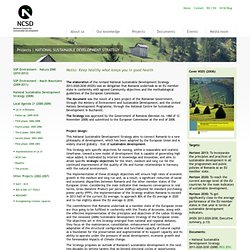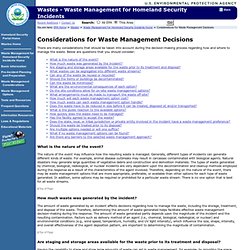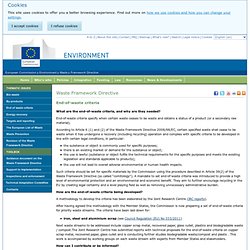

RefWorks Home Page. National Centre for Sustainable Development. The elaboration of the revised National Sustainable Development Strategy 2013-2020-2030 (NSDS) was an obligation that Romania undertook as an EU member state in conformity with agreed Community objectives and the methodological guidelines of the European Commission.

The document was the result of a joint project of the Romanian Government, through the Ministry of Environment and Sustainable Development, and the United Nations Development Programme, through the National Centre for Sustainable Development in Bucharest. The Strategy was approved by the Government of Romania (Decision no. 1460 of 12 November 2008) and submitted to the European Commission at the end of 2008. Project design: This National Sustainable Development Strategy aims to connect Romania to a new philosophy of development, which has been adopted by the European Union and is widely shared globally – that of sustainable development.
Structure: Waste Management for Homeland Security Incidents. There are many considerations that should be taken into account during the decision-making process regarding how and where to manage the waste.

Below are questions that you should consider: What is the nature of the event? The nature of the event may influence how the resulting waste is managed. Generally, different types of incidents can generate different kinds of waste. For example, animal disease outbreaks may result in carcasses contaminated with biological agents. Waste Processing. Municipal Solid Waste. Waste transfer stations are facilities where municipal solid waste is unloaded from collection vehicles and briefly held while it is reloaded onto larger long-distance transport vehicles for shipment to landfills or other treatment or disposal facilities.

By combining the loads of several individual waste collection trucks into a single shipment, communities can save money on the labor and operating costs of transporting the waste to a distant disposal site. They can also reduce the total number of vehicular trips traveling to and from the disposal site. Although waste transfer stations help reduce the impacts of trucks traveling to and from the disposal site, they can cause an increase in traffic in the immediate area where they are located. If not properly sited, designed and operated they can cause problems for residents living near them. You will need Adobe Reader to view some of the files on this page. A Regulatory Strategy for Siting and Operating Waste Transfer Stations. Diverting waste from landfill - Effectiveness of waste-management policies in the European Union — EEA. Biodegradable Waste - Environment. Additional tools Bio-waste is defined as biodegradable garden and park waste, food and kitchen waste from households, restaurants, caterers and retail premises, and comparable waste from food processing plants.

It does not include forestry or agricultural residues, manure, sewage sludge, or other biodegradable waste such as natural textiles, paper or processed wood. It also excludes those by-products of food production that never become waste. Currently the main environmental threat from biowaste (and other biodegradable waste) is the production of methane from such waste decomposing in landfills, which accounted for some 3% of total greenhouse gas emissions in the EU-15 in 1995.
The Landfill Directive (1999/31/EC) obliges Member States to reduce the amount of biodegradable municipal waste that they landfill to 35% of 1995 levels by 2016 (for some countries by 2020) which will significantly reduce this problem. L_19020060712en00010098. Waste Framework Directive - Environment. Additional tools What are the end-of-waste criteria, and why are they needed?

End-of-waste criteria specify when certain waste ceases to be waste and obtains a status of a product (or a secondary raw material). According to Article 6 (1) and (2) of the Waste Framework Directive 2008/98/EC, certain specified waste shall cease to be waste when it has undergone a recovery (including recycling) operation and complies with specific criteria to be developed in line with certain legal conditions, in particular: the substance or object is commonly used for specific purposes; there is an existing market or demand for the substance or object; the use is lawful (substance or object fulfils the technical requirements for the specific purposes and meets the exisitng legislation and standards applicable to products); the use will not lead to overall adverse environmental or human health impacts.
Waste Framework Directive - Environment. Confederation of European Waste-to-Energy Plants. Official Journal - 2005 - L 157. Ministerul Mediului. Ministry of Environment - Directorate for European Affaires and Community Policies. Implementation Plans for 12 directives and one regulation were elaborated during the negotiations for the EU accession in order to support the requested transition periods.

They were elaborated in two phases: Phase 1 Phase 2. SEPA - Mechanical biological treatment. The terms 'mechanical biological treatment' (MBT) or 'mechanical biological pre-treatment' relate to a group of solid waste systems that combines a sorting facility with a form of biological treatment such as composting or Anaerobic Digestion.

Depending on size of operation, technology used and types of waste processed, MBT plants are regulated by: Standard permits for waste operations. Use of sewage sludge in agriculture. Council Directive 86/278/EEC of 12 June 1986 on the protection of the environment, and in particular of the soil, when sewage sludge is used in agriculture [See amending acts]. Sewage sludge has valuable agronomic properties in agriculture. In using sewage sludge account must be taken of the nutrient needs of the plants without, however, impairing neither the quality of the soil nor that of surface and ground water. Some heavy metals present in sewage sludge may be toxic to plants and humans. Sewage sludge may be used in agriculture provided that the Member State concerned regulates its use.